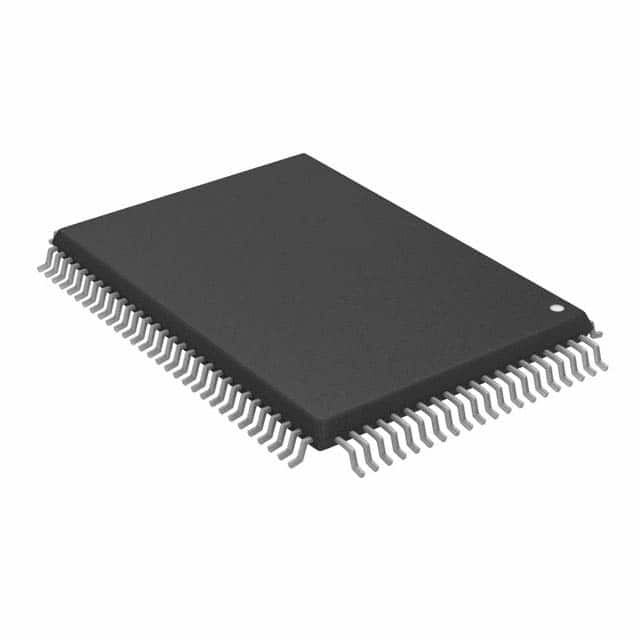Lihat spesifikasi untuk detail produk.

LC87F7NP6AVUEJ-2H
Basic Information Overview
- Category: Microcontroller
- Use: Embedded systems, electronic devices
- Characteristics: High-performance, low-power consumption
- Package: Integrated circuit (IC)
- Essence: Control and process data in electronic devices
- Packaging/Quantity: Depends on manufacturer
Specifications
- Architecture: 8-bit
- CPU Speed: Up to 16 MHz
- Flash Memory: 32 KB
- RAM: 2 KB
- Operating Voltage: 2.2V - 5.5V
- I/O Pins: 28
- Communication Interfaces: UART, SPI, I2C
- Timers/Counters: 4
- ADC Channels: 8
- PWM Channels: 4
Detailed Pin Configuration
- VDD: Power supply voltage
- GND: Ground
- P0.0: General-purpose I/O pin
- P0.1: General-purpose I/O pin
- P0.2: General-purpose I/O pin
- P0.3: General-purpose I/O pin
- P0.4: General-purpose I/O pin
- P0.5: General-purpose I/O pin
- P0.6: General-purpose I/O pin
- P0.7: General-purpose I/O pin
- P1.0: General-purpose I/O pin
- P1.1: General-purpose I/O pin
- P1.2: General-purpose I/O pin
- P1.3: General-purpose I/O pin
- P1.4: General-purpose I/O pin
- P1.5: General-purpose I/O pin
- P1.6: General-purpose I/O pin
- P1.7: General-purpose I/O pin
- RST: Reset pin
- XTAL1: Crystal oscillator input
- XTAL2: Crystal oscillator output
- VSS: Ground
- AIN0: Analog input channel 0
- AIN1: Analog input channel 1
- AIN2: Analog input channel 2
- AIN3: Analog input channel 3
- VREF: Reference voltage for ADC
- AVSS: Ground for analog circuitry
Functional Features
- High-performance CPU for efficient data processing
- Low-power consumption for extended battery life
- Multiple communication interfaces for connectivity
- Analog-to-digital converter (ADC) for sensor integration
- Pulse-width modulation (PWM) for precise control
- Timers/counters for accurate timing operations
Advantages and Disadvantages
Advantages
- High-performance capabilities
- Low-power consumption
- Versatile communication interfaces
- Integrated analog and digital features
Disadvantages
- Limited flash memory and RAM capacity
- Limited number of I/O pins
- May require additional external components for certain applications
Working Principles
LC87F7NP6AVUEJ-2H is based on an 8-bit architecture and operates at a maximum speed of 16 MHz. It utilizes a combination of hardware and software to control and process data in electronic devices. The microcontroller executes instructions stored in its flash memory, interacts with peripherals through various communication interfaces, and performs tasks based on the program logic.
Detailed Application Field Plans
The LC87F7NP6AVUEJ-2H microcontroller finds applications in various fields, including: 1. Home automation systems 2. Industrial control systems 3. Automotive electronics 4. Consumer electronics 5. Medical devices
Detailed and Complete Alternative Models
- LC87F7NP6A: Similar microcontroller with different package options
- LC87F7NP6BVUEJ-2H: Variant with additional features and higher performance
- LC87F7NP6CVUEJ-2H: Variant with increased flash memory and RAM capacity
(Note: The above alternative models are for illustrative purposes only and may not represent actual alternatives available in the market.)
This entry provides an overview of the LC87F7NP6AVUEJ-2H microcontroller, including its basic information, specifications, pin configuration, functional features, advantages and disadvantages, working principles, application field plans, and alternative models.
Sebutkan 10 pertanyaan dan jawaban umum terkait penerapan LC87F7NP6AVUEJ-2H dalam solusi teknis
Sure! Here are 10 common questions and answers related to the application of LC87F7NP6AVUEJ-2H in technical solutions:
1. What is LC87F7NP6AVUEJ-2H? LC87F7NP6AVUEJ-2H is a microcontroller chip manufactured by a specific company. It is commonly used in various technical solutions due to its features and capabilities.
2. What are the key features of LC87F7NP6AVUEJ-2H? Some key features of LC87F7NP6AVUEJ-2H include high-performance processing, low power consumption, multiple I/O ports, built-in memory, analog-to-digital converters, timers, and communication interfaces.
3. In what applications can LC87F7NP6AVUEJ-2H be used? LC87F7NP6AVUEJ-2H can be used in a wide range of applications such as industrial automation, consumer electronics, automotive systems, medical devices, home appliances, and more.
4. How does LC87F7NP6AVUEJ-2H contribute to energy efficiency? LC87F7NP6AVUEJ-2H is designed with low power consumption in mind. It incorporates power-saving modes, efficient clock management, and optimized algorithms to minimize energy usage in various applications.
5. Can LC87F7NP6AVUEJ-2H support real-time operating systems (RTOS)? Yes, LC87F7NP6AVUEJ-2H can support real-time operating systems. It has sufficient processing power, memory, and I/O capabilities to handle the requirements of most RTOS implementations.
6. Is LC87F7NP6AVUEJ-2H compatible with other microcontrollers or development tools? LC87F7NP6AVUEJ-2H is compatible with various development tools and software environments. It supports standard programming languages, debuggers, and integrated development environments (IDEs) commonly used in the industry.
7. What communication interfaces are available on LC87F7NP6AVUEJ-2H? LC87F7NP6AVUEJ-2H provides multiple communication interfaces such as UART, SPI, I2C, CAN, USB, Ethernet, and more. These interfaces enable seamless integration with other devices and systems.
8. Can LC87F7NP6AVUEJ-2H be used for data acquisition and sensor interfacing? Yes, LC87F7NP6AVUEJ-2H has built-in analog-to-digital converters (ADCs) that allow it to interface with sensors and acquire data. It can process and analyze sensor inputs for various applications.
9. Does LC87F7NP6AVUEJ-2H have any security features? LC87F7NP6AVUEJ-2H incorporates various security features such as memory protection, encryption algorithms, secure boot, and tamper detection mechanisms to enhance the security of the overall system.
10. How can I get started with LC87F7NP6AVUEJ-2H development? To get started with LC87F7NP6AVUEJ-2H development, you can refer to the manufacturer's documentation, datasheets, application notes, and development kits. Additionally, online communities and forums can provide valuable resources and support for your specific needs.
Please note that the specific details and answers may vary depending on the actual specifications and documentation provided by the manufacturer of LC87F7NP6AVUEJ-2H.

